Physical Address
304 North Cardinal St.
Dorchester Center, MA 02124
On completion of this chapter, you should be able to:
Describe how amniotic fluid is derived
Describe the production of amniotic fluid
List the functions of amniotic fluid
Describe methods for assessing amniotic fluid volume
Determine abnormal volumes of amniotic fluid
Understand the significance of ruptured membranes
Describe the significance of amniotic band syndrome
Differentiate amniotic band syndrome from amniotic sheets with sonography
Distinguish between immune and nonimmune hydrops
Identify causes of hydrops
Recognize the sonographic features of hydrops
Amniotic fluid plays a vital role in fetal growth and serves several important functions during intrauterine life. Amniotic fluid allows the fetus to move freely within the amniotic cavity while maintaining intrauterine temperature and protecting the developing fetus. Abnormalities of the fluid may interfere with normal fetal development and cause structural abnormalities or may represent an indirect sign of an underlying anomaly.
The amniotic cavity forms early in fetal life and is filled with amniotic fluid. The fluid surrounds and protects the embryo and, later, the fetus. Amniotic fluid is produced by the umbilical cord, the membranes, lungs, skin, and kidneys. The amount of amniotic fluid present reflects a balance between amniotic fluid production and amniotic fluid removal. The mechanisms of amniotic fluid production and consumption and the composition and volume of amniotic fluid depend on gestational age.
Early in gestation, the main source of amniotic fluid is the amniotic membrane, a thin membrane lined by a single layer of epithelial cells. During this stage of development, water crosses the membrane freely, and the production of amniotic fluid is accomplished by active transport of electrolytes and other solutes by the amnion, with passive diffusion of water following in response to osmotic pressure changes.
As the fetus and placenta mature, amniotic fluid production and consumption change. The change includes movement of fluid across the chorion frondosum and fetal skin, fetal urine output and fetal swallowing, and gastrointestinal absorption. The chorion frondosum (the portion of the chorion that develops into the fetal portion of the placenta) is a site where water is exchanged freely between fetal blood and amniotic fluid across the amnion. Fetal skin is also permeable to water and some solutes to permit a direct exchange between the fetus and amniotic fluid until keratinization occurs at 24 to 26 weeks. Fetal production of urine and the ability to swallow begins between 8 and 11 weeks of gestation. The amount of urine produced is most significant at approximately 18 to 20 weeks of gestation. Fetal urination into the amniotic sac accounts for nearly the total volume of amniotic fluid by the second half of pregnancy. The quantity of fluid is directly related to kidney function and urination. In turn, the fetus swallows amniotic fluid, which is absorbed by the digestive tract.
Amniotic fluid has the following six functions:
Acts as a cushion to protect the fetus
Allows embryonic and fetal movements
Prevents adherence of the amnion to the embryo
Allows symmetric growth
Maintains a constant temperature
Acts as a reservoir to fetal metabolites before their excretion by the maternal system
The amount of amniotic fluid is regulated not only by the production of fluid but also by removal of the fluid by swallowing, by fluid exchange within the lungs, the membranes, and the umbilical cord ( Fig. 58.1 ). Normal lung development depends critically on the exchange of amniotic fluid within the lungs. Inadequate lung development may occur when the amount of amniotic fluid is severely low, placing the fetus at high risk for developing small or hypoplastic lungs.
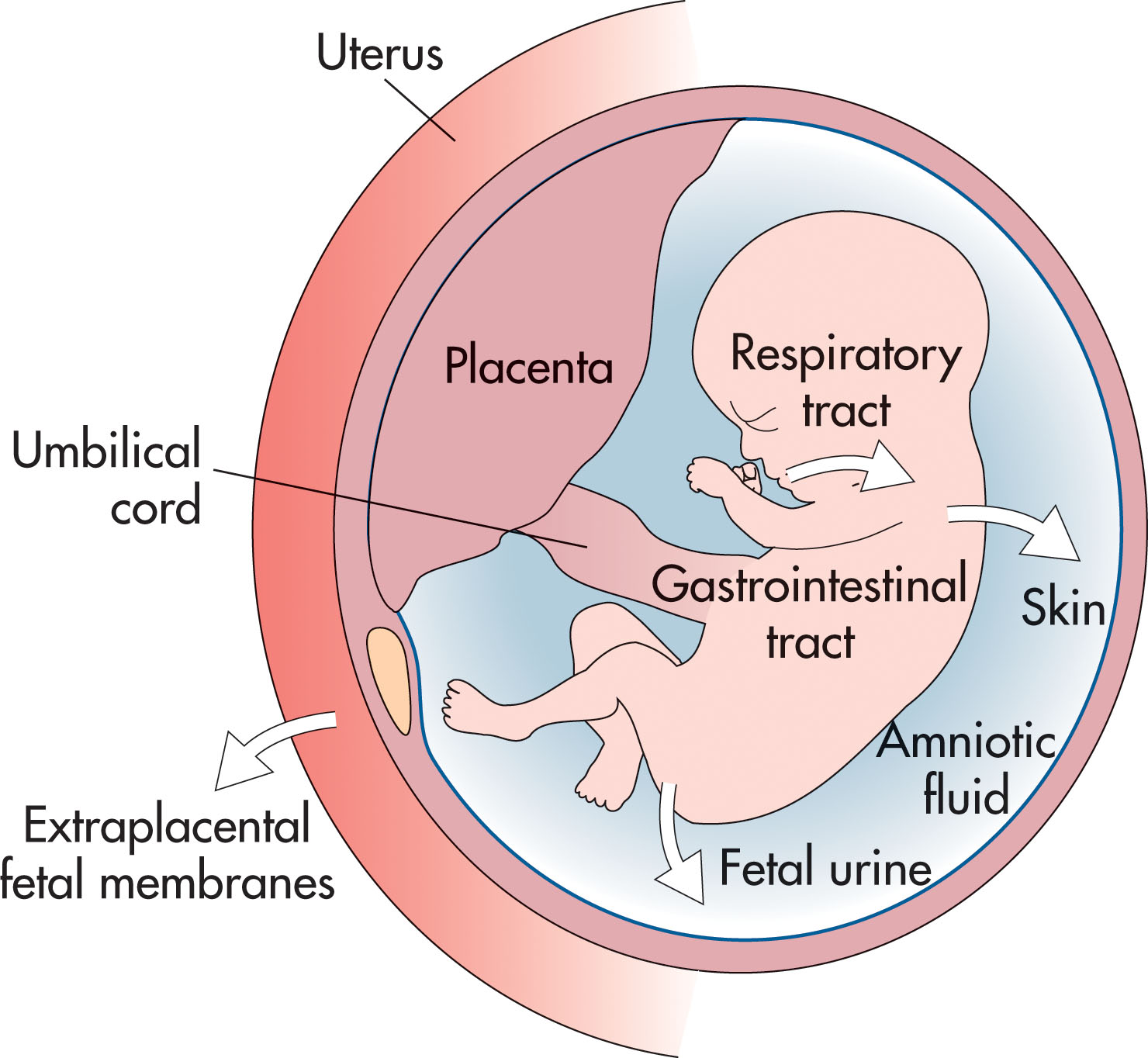
The volume of amniotic fluid increases progressively until about 33 weeks of gestation, with the average increment per week of 25 mL from the 11th to the 15th week and 50 mL from the 15th to 28th week of gestation. In the last trimester, the mean amniotic fluid volume does not change significantly ( Box 58.1 ). The sonographer must be aware of the relative differences in amniotic fluid volume throughout pregnancy. During the second and early third trimester of pregnancy, amniotic fluid appears to surround the fetus and should be readily visible. From 20 to 30 weeks of gestation, amniotic fluid may appear rather generous, although this typically represents a normal amniotic fluid variant. By the end of pregnancy, the amniotic fluid is limited and appears sonographically as isolated fluid pockets. Toward the end of the pregnancy, after 38 weeks of gestation, there is a general decline in the amniotic fluid.
Amniotic fluid volume increases rapidly during first trimester
Fetus swallows fluid; reabsorbed by gastrointestinal tract; recirculates through kidneys
Increased amniotic fluid production in first trimester
By 20 weeks of gestation, amniotic fluid volume increases by 10 mL/day
Amount of fluid produced by fetal urination slightly exceeds amount removed by fetal swallowing; less than 40% of fluid increase originates from other sources
Amniotic fluid generally appears echo-free, although occasionally, echogenic fluid particles may be seen ( Fig. 58.2 ). The echogenic fluid particles may represent a normal variant, particulate matter, vernix caseosa , intraamniotic blood, or intrauterine meconium passage. The term amniotic sludge has been used to describe a dense collection of echogenic particles within the fluid at the level of the cervix. The presence of sludge may be related to intrauterine infection and is associated with the risk of preterm premature rupture of membranes (ROM), chorioamnionitis, and preterm delivery. In cases of intrauterine meconium passage, the amniotic fluid may take on an echogenic “snowstorm” appearance.
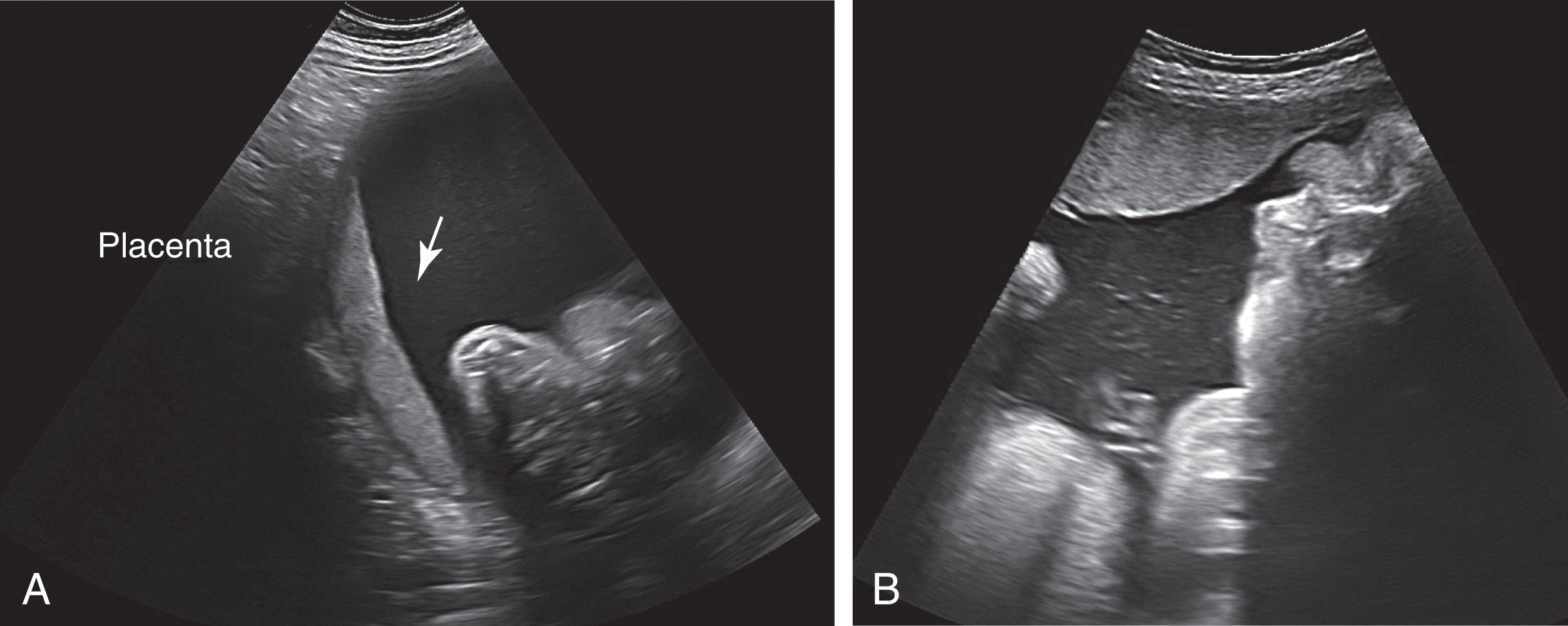
In accordance with the guidelines for obstetric scanning, every obstetric examination should include a thorough evaluation of amniotic fluid volume. Abnormal amounts of amniotic fluid are described as hydramnios ( polyhydramnios ) and oligohydramnios. Hydramnios refers to an increase of amniotic fluid, whereas oligohydramnios refers to a decreased amount of amniotic fluid. When extremes in amniotic fluid volume (hydramnios or oligohydramnios) are found, targeted studies for the exclusion of fetal anomalies are recommended. In some instances, the cause of the abnormal fluid levels may be associated with maternal factors, unknown etiologies, or correlation with fetal weight (small-for-age fetus has decreased amniotic fluid, whereas large-for-age fetus has increased volume of fluid). The amount of amniotic fluid present can be determined in several ways.
Subjective assessment is performed as the sonographer initially scans “through” the entire uterus to determine the visual assessment of the fluid present, fetal position, and the location of the placenta ( Fig. 58.3 ). When amniotic fluid is assessed subjectively, decreased amniotic fluid is identified by an overall sense of crowding of the fetus and obvious lack of amniotic fluid and/or inability to identify any significant pockets of fluid in any sector of the uterus ( Fig. 58.4 ). Excessive fluid is defined subjectively; when there is an obvious excess of fluid, the fetus appears in the most dependent portion of the uterus, or the fetus appears to move excessively for the gestational age ( Fig. 58.5 ). This subjective assessment is more successful in the hands of experienced sonographers than in the hands of a beginner. The subjective assessment leads the sonographer to perform a more quantitative method to document the amount of amniotic fluid.
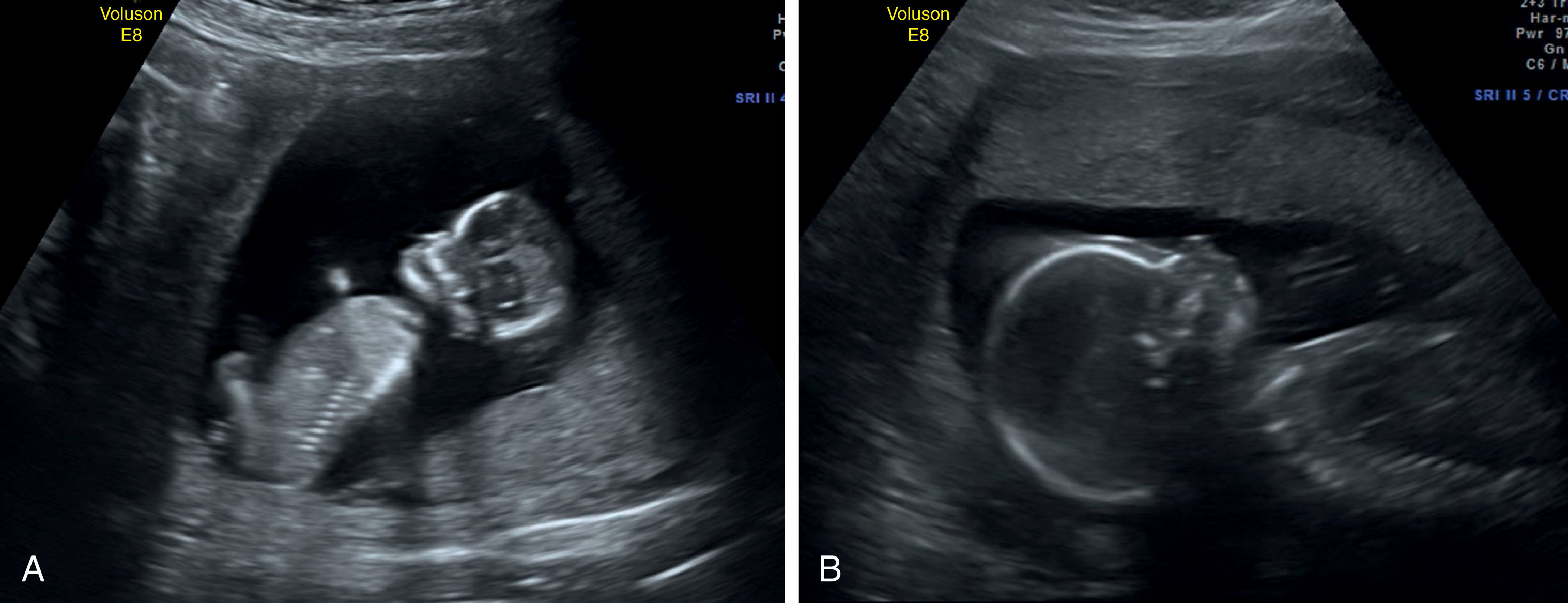

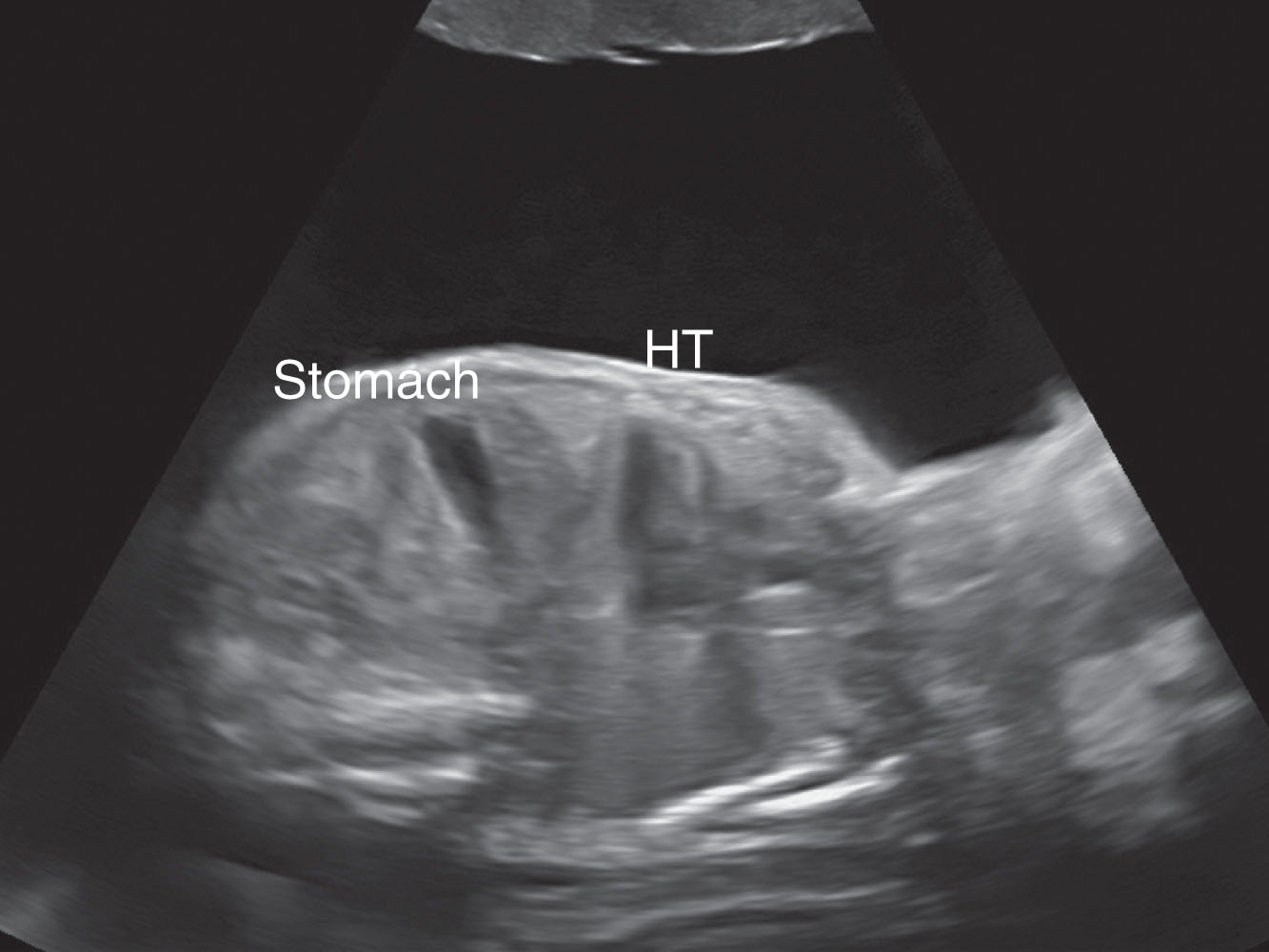
Several methods are used to calculate an amniotic fluid measurement. Each obstetric center may use one or a combination of the methods. These methods include amniotic fluid index (AFI), single pocket assessment, and two-diameter pocket assessment. Each department should have clear guidelines for sonographers to use when assessing amniotic fluid. These guidelines will help to aid in proper amniotic fluid assessments when multiple sonographers are monitoring the same patient.
The amniotic fluid index (AFI) is used most frequently for evaluating and quantifying amniotic fluid volume at different intervals during a pregnancy. The AFI method is both a valid and a reproducible technique. With this method, the uterine cavity is divided into four equal quadrants by two imaginary lines perpendicular to each other ( Fig. 58.6 ). The largest vertical pocket of amniotic fluid, excluding fetal structures, or umbilical cord loops, is measured.
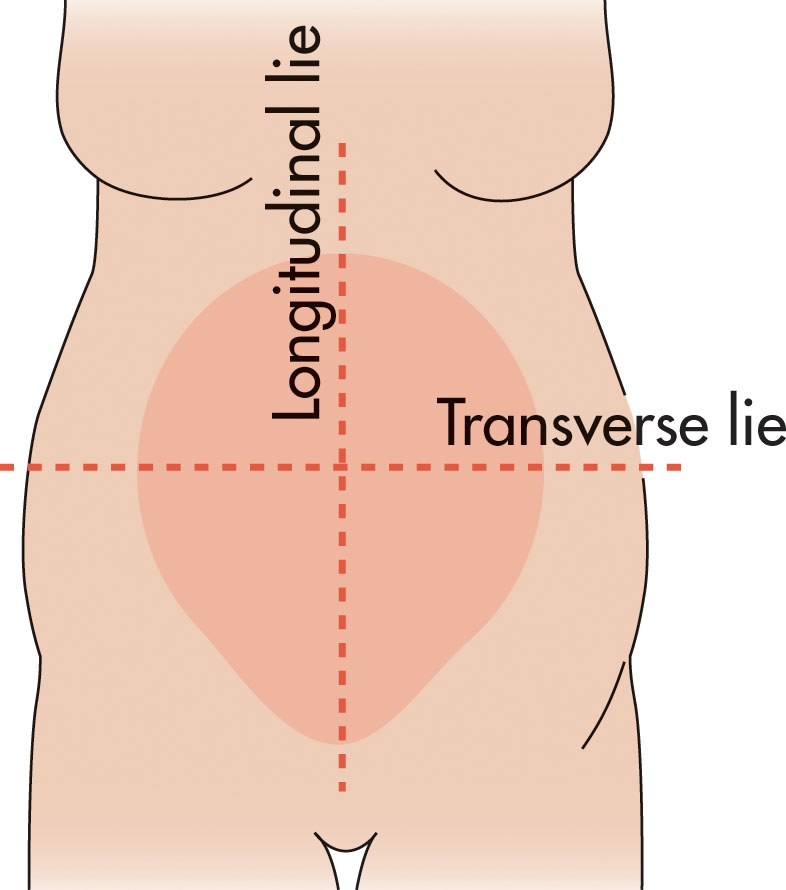
The sonographer should hold the transducer in the sagittal plane and perpendicular to the table (not the curved skin surface) when determining these pockets of fluid. Each quadrant should be evaluated to reflect the most accurate display of fluid. The transducer should be moved until the cord loops and/or fetal structures are not visualized within the pocket of fluid ( Fig. 58.7 ). Care must be taken not to include the thickness of the maternal uterine wall in the measurement or apply too much pressure to the skin, causing the pocket of fluid to appear smaller. Slight adjustment of the gain will aid in the visualization of the uterine wall or visualization of the umbilical cord within the fluid. Color Doppler technology can be used to document a pocket of fluid free of the umbilical cord or any fetal structures.
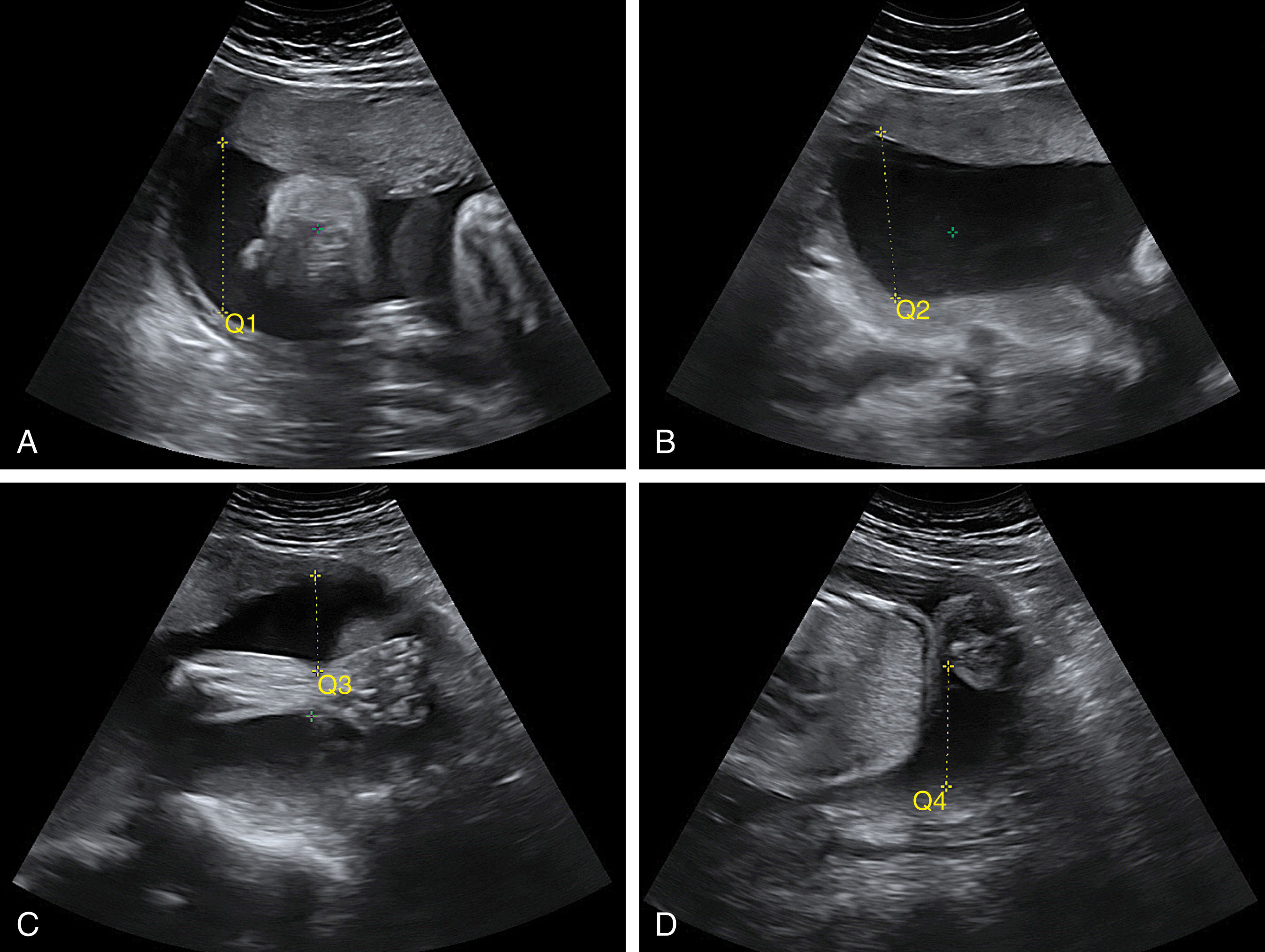
Normal values have been calculated for each gestational age (±2 standard deviations). The values are relatively stable after 20 weeks until the end of the third trimester. The AFI peaks late in the third trimester of pregnancy, with a rapid decline near term.
Normal amniotic fluid correlates with an AFI of 10 to 20 cm.
Borderline values of 5 to 10 cm indicate low fluid, and values of 20 to 24 cm indicate increased fluid.
Oligohydramnios correlates with an AFI of less than 5 cm, with the largest vertical pocket measuring 2 cm or less.
Polyhydramnios correlates with an AFI of greater than 24 cm and the largest vertical pocket of 8 cm or more.
The maximum vertical pocket assessment of amniotic fluid is done by identifying the largest pocket of amniotic fluid ( Fig. 58.8 ). The pocket of fluid should be clear of fetal structures as well as the umbilical cord. As with the AFI, the gain should be adjusted for clear visualization of the uterine wall, and minimum pressure to the abdomen should be applied. The depth of the pocket is measured at right angles to the uterine contour and placed into three categories:
Less than 2 cm, indicating oligohydramnios
From 2 to 8 cm, indicating normal amniotic fluid
Greater than 8 cm, indicating polyhydramnios

The two-diameter pocket determination uses the largest pocket of amniotic fluid. The horizontal and vertical dimensions of the maximum vertical pocket are multiplied together to obtain a single volume. A two-diameter pocket of 15 to 50 cm is considered normal ( Fig. 58.9 ).
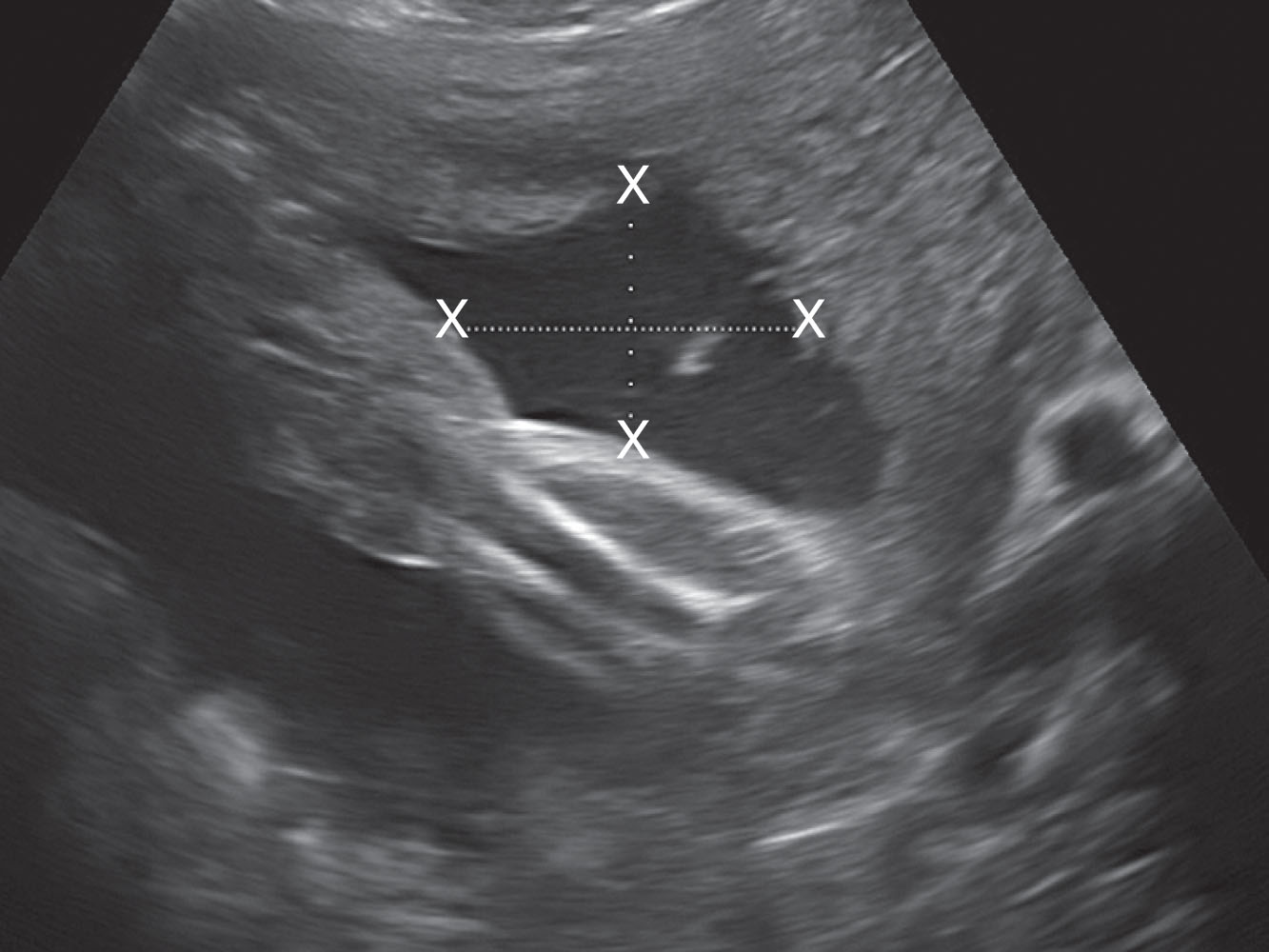
In twin pregnancies, it is important to assess each sac independently when performing amniotic fluid determinations ( Fig. 58.10 ). Twin pregnancies have a slightly lower median AFI value than singleton pregnancies. However, in polyhydramnios, the largest vertical pocket has been reported to be more accurate ( Fig. 58.11 ). Because the AFI gives an overall assessment of the pregnancy, it does not accurately show differences between sacs. The only method for accurately determining the amount of amniotic fluid is the dye-determined method. It can be used in singleton or multiple gestations. The dye technique requires injection of dye into the sac(s) via amniocentesis; after 20 minutes, another amniocentesis is performed in which 1 mL greater than the injected dye is removed and frozen; and then the fluid/dye mixture is evaluated for the amount of concentrate, which determines the amniotic fluid volume.
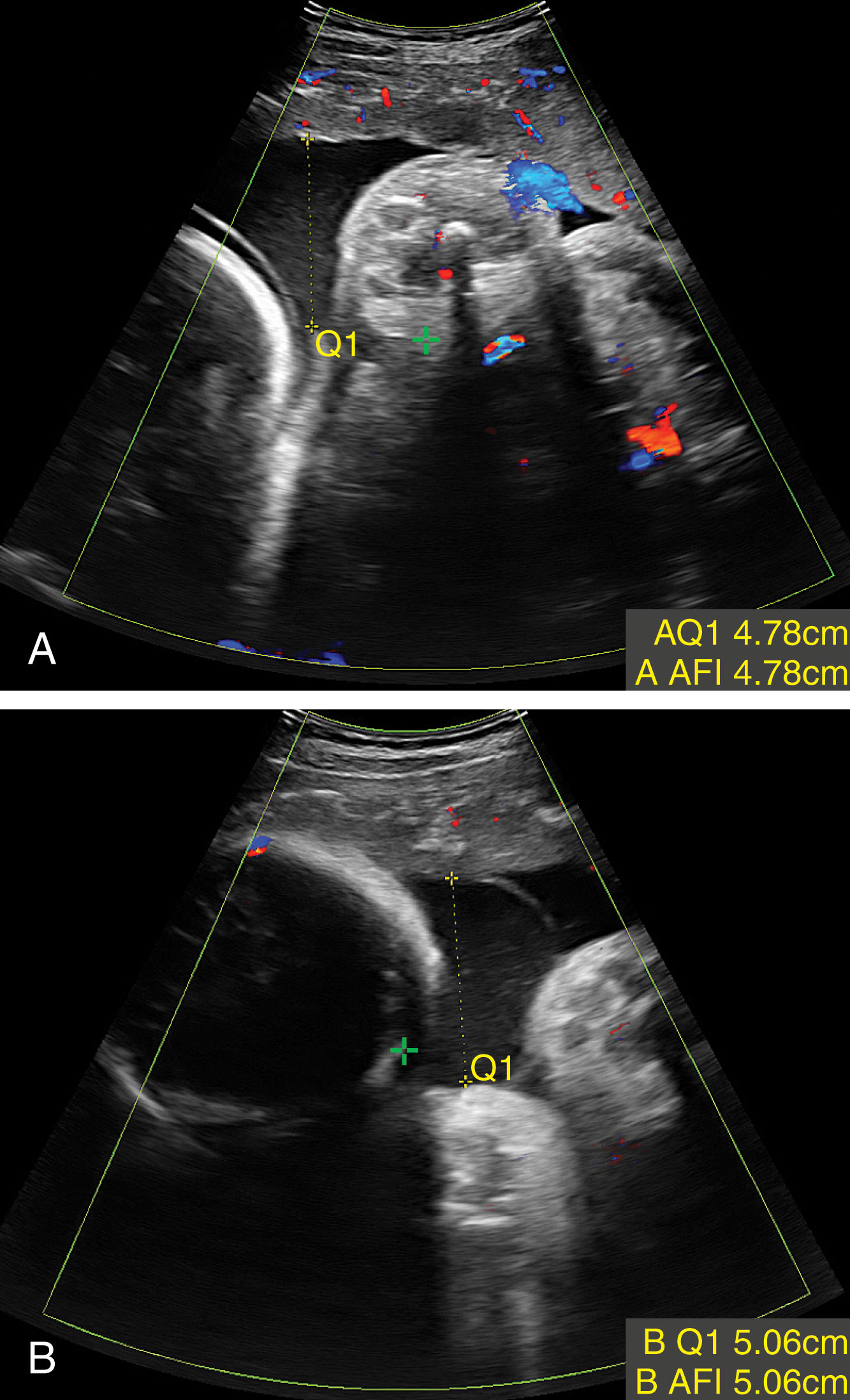
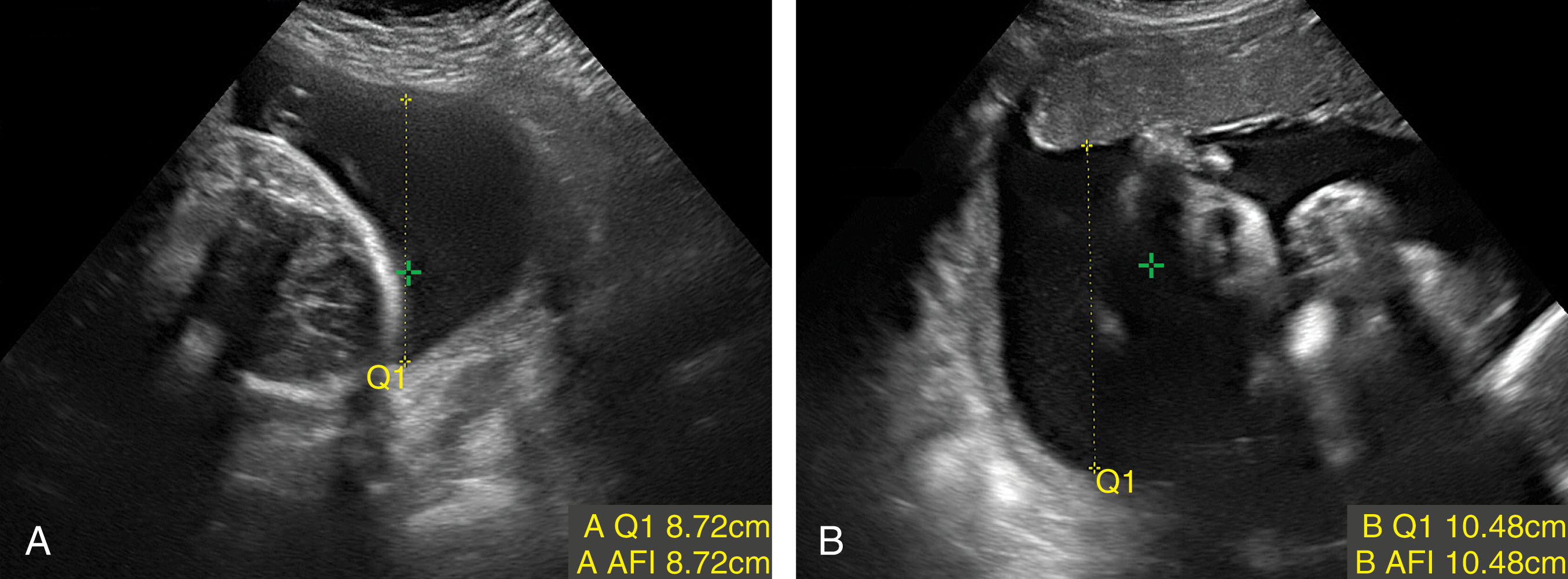
Polyhydramnios (also known as hydramnios) is defined as an amniotic fluid volume of greater than 2000 mL. In addition, the finding of polyhydramnios is associated with increased perinatal mortality and morbidity and maternal complications. By clinical definition, polyhydramnios is an excessive amount of fluid that causes the uterine size to be larger than expected for gestational age. Often the patient will present for a sonographic examination with the clinical finding of uterus larger than dates.
The amniotic fluid compartment is in a dynamic equilibrium with the fetal and maternal compartments. In polyhydramnios, the equilibrium shifts so that the net transfer of water is into the amniotic space. As discussed earlier, many factors are involved in the regulation of amniotic fluid volume (e.g., swallowing, urination, uterine-placental blood flow, fetal respiratory movements, and fetal membrane physiology).
Increased amniotic fluid volume produces uterine stretching and enlargement that may lead to preterm labor and various other maternal symptoms. In addition, the acute onset of hydramnios may result in painful maternal clinical symptoms, compress other organs or vascular structures, cause hydronephrosis of the kidneys, or produce shortness of breath from compression of the organs on the diaphragm.
Often polyhydramnios may be diagnosed sonographically before it is clinically suspected. Chronic hydramnios characteristically develops between the 28th week of gestation and term. Acute polyhydramnios may develop over a few days or chronically over weeks. Acute polyhydramnios occurs in the second trimester and accounts for only 2% of the cases. Usually, the cause of acute polyhydramnios is congenital anomalies or twin-to-twin transfusion syndrome.
Polyhydramnios is often associated with central nervous system disorders and/or gastrointestinal problems. Central nervous system disorders cause depressed swallowing. With gastrointestinal abnormalities, often a blockage (atresia) of the esophagus, stomach, duodenum, or small bowel results in ineffective swallowing. Fetal hydrops, skeletal anomalies, and some renal disorders (usually unilateral) may also be associated with hydramnios. Other forms of polyhydramnios that cannot be explained by congenital anomalies are considered idiopathic ( Box 58.2 ). Maternal conditions such as diabetes mellitus, obesity, Rh incompatibility, anemia, congestive cardiac failure, and syphilis have been associated with polyhydramnios.
Esophageal atresia and/or tracheoesophageal fistula
Duodenal atresia
Jejunoileal atresia
Gastroschisis
Omphalocele
Diaphragmatic hernia
Meckel diverticulum
Congenital megacolon
Meconium peritonitis
Annular pancreas
Pancreatic cyst
Become a Clinical Tree membership for Full access and enjoy Unlimited articles
If you are a member. Log in here